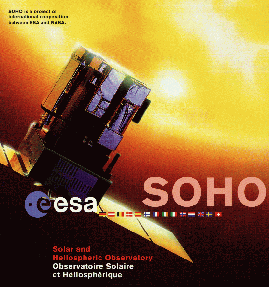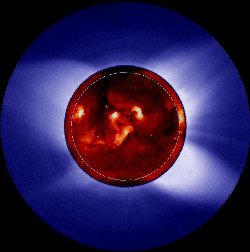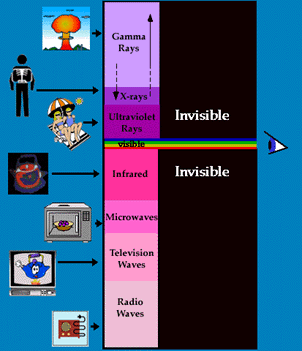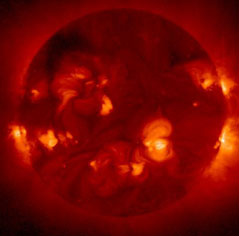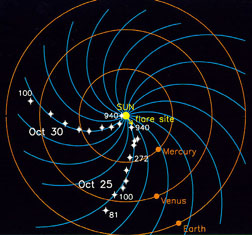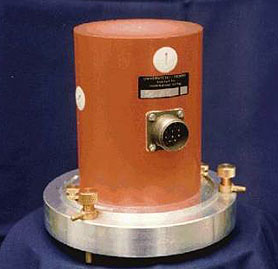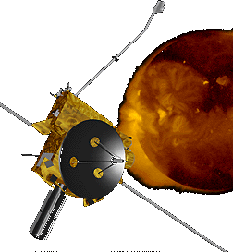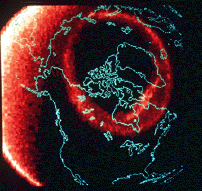Click on image for full size
Image courtesy of NASA
How do Satellites & Spacecraft Monitor Space Weather?
Satellites and other spacecraft help us observe space weather. They collect data about the Sun, Earth's magnetosphere, Earth's atmosphere, and space weather throughout the rest of our Solar System.
Spacecraft that Watch the Sun
Some spacecraft watch the Sun. They have special telescopes for looking at the Sun and the Sun's atmosphere. Some can "see" the Sun in wavelengths, like X-rays, that cannot be viewed from Earth's surface. Some spacecraft carry instruments called coronagraphs that make artificial eclipses. Astronomers use coronagraphs to study the Sun's atmosphere.
Spacecraft that Measure the Solar Wind
The solar wind of charged particles flows outward from the Sun. It carries the Interplanetary Magnetic Field (IMF) with it. Spacecraft measure the solar wind and the IMF. They record the speed and density of the solar wind. They measure the strength and direction of the IMF. Some satellites and other spacecraft make these measurements near Earth. Other spacecraft record observations of the solar wind and IMF near other planets, on their way to comets or asteroids, or in the depths of "empty" space between the planets.
Spacecraft that Observe Magnetospheres
Some planets and moons have magnetic fields. Earth has a fairly strong magnetic field. Planets and moons with strong magnetic fields make "magnetic bubbles", called magnetospheres, around themselves in space. Charged particles swirl around in magnetospheres in complex patterns. Satellites orbiting Earth observe our planet's magnetosphere. Spacecraft that fly by or orbit other planets with magnetic fields measure the magnetospheres there. They measure the strength and direction of the magnetic field all around the planet. They observe radiation belts, measure the density of charged particles, and record the strengths of electrical currents.
Watching the Aurora from Space
Have you ever seen the Northern (or Southern) Lights? The aurora, as these lights are also called, can often be seen from places at high latitudes on Earth - like Scandinavia, Greenland, Canada, Alaska, Russia, and Antarctica. Guess what? They can also be seen from space! Astronauts have taken pictures of aurora. Spacecraft that fly in higher orbits observe the whole auroral oval around a pole at once. The Hubble Space Telescope and some other spacecraft have also taken pictures of auroras at the poles of other planets!
Keeping an Eye on the Atmosphere
Space weather causes changes in Earth's atmosphere. Satellites help us keep track of how the atmosphere changes. One part of the atmosphere, the ionosphere, has lots of electrically charged particles in it. Stations on the ground work with satellites to beam radio waves through the ionosphere. The particles in the ionosphere affect the radio signals, allowing scientists to measure the ionosphere. They can see how the ionosphere changes as space weather changes.
Special Orbits for Space Weather Spacecraft
Some of the spacecraft that observe space weather are in special orbits. Some satellites loop over the North and South Poles in polar orbits that let them watch auroras. Some hover at a special "LaGrange point" between Earth and the Sun that lets them detect the solar wind a little while before it gets to our planet.


